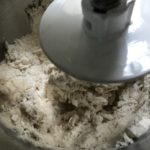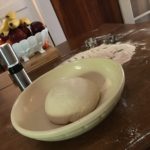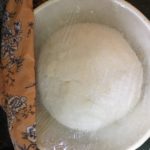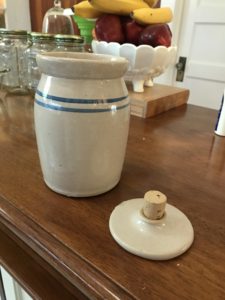Today was the big day! I started my first scratch sourdough loaf today, and feel pretty good with the results.
 So about three weeks ago, I started my first sourdough starter… And it worked! Daily feedings for the first week or two, then every other day. It bubbled, grew, and crusted over, and got good and sour. A couple times I thought I screwed up because I missed a feeding or didn’t cover it. I was surprised how well it went.
So about three weeks ago, I started my first sourdough starter… And it worked! Daily feedings for the first week or two, then every other day. It bubbled, grew, and crusted over, and got good and sour. A couple times I thought I screwed up because I missed a feeding or didn’t cover it. I was surprised how well it went.

This post made it sound entirely possible, and since I live in San Francisco – a town famous for our unique sourdough – I figured it was worth a shot. Then, I ordered the Tartine Bread book. On pages 45/46 this treasure of a book gives a different perspective on starting your own starter than did the article from King Arthur – but the same basic idea: Flour, Water, Love and Patience. It takes the perspective of a baker – referencing things in terms of ratios and percentages. This will, I’m sure, be helpful to me in the long run but I decided it was going to be trickier for me to be successful this first time and so I opted for a measuring system I’m more familiar with – you’ll see that below.
I think the most important advice I read was that this whole process is as much about intuition and “feel” as it is about perfect measurements and science. Your dough and levin will take different amounts of time to develop depending on a number of factors: weather, temperature, humidity, and of course local bacteria.
One peice of advice I found helpful was how clearly Tartine Bread describes the smells you’ll want to identify to know your leaven is ready. “Sweet in an over-ripe fruit sort of way.” “Sour but not vinegary.” Another great thing to know is the float test: If your leaven is ready, it will float. So, to test it, simply drop a spoonful into a bowl of room-temperature water. If it sinks, it needs more time to ferment and ripen.
I was a little surprised by how looooong this method took to raise – most of the day – but I was patient with it, and my patience paid off! If you have less time, feel free to follow a number of other recipes that integrate active dry yeast in addition to the fresh sourdough starter. But either way, plan ahead and be sure you have the time to be relaxed. The exciting thing about this process is that you’re working with a living breathing organism.
Ingredients
- 1 cup “fed” sourdough starter, prepped the night before, as described above.
- 1 1/2 cups lukewarm water
- 5 cups unbleached flour
- 1 tablespoon sugar
- 2 1/2 teaspoons salt
- 5 minutes, overnight, 15 minutes, 2ish hours, 20 minutes, 4 hours, 5 minutes, 2 hours, 30 minutes.
Here’s what I did:

- Combine the prepared starter, water, and 3 cups of the flour. I used my kitchenaid for this step, and my bread hook to beat it vigorously for a minute or three.
- I used the same towel I’d been using on my starter to cover the bowl, and let rest at room temperature for an hour, then into my 100-degree warming oven for another 2-3 hours. At this point, you could refrigerate overnight, for about 12 hours – but I didn’t. I just let it raise in the warm oven and I think it did well. Next time, I might do an overnight rise…
 When you’ve completed the first rise, add the remaining ingredients: 2 cups of flour, sugar, and salt. You can also add a “kick” by including citric acid here, but don’t use more than about1/2 a teaspoon. At this step, I hand kneaded everything together on my big wooden island. This is the therapeutic part – but I didn’t over-knead. The goal is to bring the elements together to form a smooth dough, and then form a ball.
When you’ve completed the first rise, add the remaining ingredients: 2 cups of flour, sugar, and salt. You can also add a “kick” by including citric acid here, but don’t use more than about1/2 a teaspoon. At this step, I hand kneaded everything together on my big wooden island. This is the therapeutic part – but I didn’t over-knead. The goal is to bring the elements together to form a smooth dough, and then form a ball. I have a beautiful large wide shallow bowl from the 1930s that is perfect for this next step: Spray whatever large container you’re going to use for this raising with oil. I use my Misto and some nice olive oil for this, but if you have cooking spray that will work or you can smear it with butter by hand. Lay your dough ball in the bowl, and cover it; A great tip I got was to spray a piece of plastic wrap with oil and cover the bowl with that first. I dampened the dishtowel down with water and laid it over the top, before tucking it back in the warm oven. Allow your dough to rise in a covered bowl until it’s relaxed, smoothed out, and larger. Depending on the vigor of your starter, it may become REALLY puffy, as pictured; or it may just rise a bit. This can take anywhere from 2 to 5 hours.
I have a beautiful large wide shallow bowl from the 1930s that is perfect for this next step: Spray whatever large container you’re going to use for this raising with oil. I use my Misto and some nice olive oil for this, but if you have cooking spray that will work or you can smear it with butter by hand. Lay your dough ball in the bowl, and cover it; A great tip I got was to spray a piece of plastic wrap with oil and cover the bowl with that first. I dampened the dishtowel down with water and laid it over the top, before tucking it back in the warm oven. Allow your dough to rise in a covered bowl until it’s relaxed, smoothed out, and larger. Depending on the vigor of your starter, it may become REALLY puffy, as pictured; or it may just rise a bit. This can take anywhere from 2 to 5 hours.  Understand, again, that sourdough bread (especially sourdough without added yeast) is as much art as science; everyone’s timetable, each time, will be different. So please allow yourself to go with the flow!
Understand, again, that sourdough bread (especially sourdough without added yeast) is as much art as science; everyone’s timetable, each time, will be different. So please allow yourself to go with the flow!

 Gently divide the dough in half – I used my pastry knife because I didn’t want to deflate it anymore than I had to. I was really happy with the height. Then, gently shape the dough into two oval loaves, and place them on a lightly greased or parchment-lined baking sheet. I love baking sheets, but I’ve also been reading about dutch ovens and several other bread methods that I will try in the future. This is the third rise, and it’s where I made what I consider one of three minor mistakes: You cover the loaves with lightly greased plastic wrap and let rise until very puffy, about 2 to 4 hours. Don’t worry if the loaves spread more than they rise; they’ll pick up once they hit the oven’s heat. Mine spread more than they rose – and part of that is because I had the plastic wrap on too tight. Next time, I’ll leave it loose and add a damp towel again. I think the moisture will make a difference.
Gently divide the dough in half – I used my pastry knife because I didn’t want to deflate it anymore than I had to. I was really happy with the height. Then, gently shape the dough into two oval loaves, and place them on a lightly greased or parchment-lined baking sheet. I love baking sheets, but I’ve also been reading about dutch ovens and several other bread methods that I will try in the future. This is the third rise, and it’s where I made what I consider one of three minor mistakes: You cover the loaves with lightly greased plastic wrap and let rise until very puffy, about 2 to 4 hours. Don’t worry if the loaves spread more than they rise; they’ll pick up once they hit the oven’s heat. Mine spread more than they rose – and part of that is because I had the plastic wrap on too tight. Next time, I’ll leave it loose and add a damp towel again. I think the moisture will make a difference.  Towards the end of the rising time, preheat the oven to 425°F.
Towards the end of the rising time, preheat the oven to 425°F.- (This was my second minor mistake: I missed this step altogether.) Spray the loaves with lukewarm water. This is to help form the crust.
 Make two fairly deep diagonal slashes in each; a serrated bread knife, wielded firmly, works well here. This part was fun – it really works, and it’s super soft. A serrated blade will be better because it will keep you from using too much pressure and flattening your now-puffy loaves.
Make two fairly deep diagonal slashes in each; a serrated bread knife, wielded firmly, works well here. This part was fun – it really works, and it’s super soft. A serrated blade will be better because it will keep you from using too much pressure and flattening your now-puffy loaves.
 Now, it’s time to bake! Slip the loaves in the oven for 25 to 30 minutes, until they are a very deep golden brown. I will add: Getting the humidity right is a key part of this step, and to ensure I was getting some extra moisture in my oven, I stuck a casserole pan filled with water on the lower shelf like a steam tray. This also helps the bread to form a nice crust. I carefully set my alarm, and by the time 25 minutes had passed my loaves were a little too well-done. Another time, I’ll set a shorter alarm to check them sooner – but they’re sill good. Be sure to remove the loaves from the pan and allow them to cool on a rack. Before mine were cooled, I buttered them to crisp up the crust, which also gave them a nice shine.
Now, it’s time to bake! Slip the loaves in the oven for 25 to 30 minutes, until they are a very deep golden brown. I will add: Getting the humidity right is a key part of this step, and to ensure I was getting some extra moisture in my oven, I stuck a casserole pan filled with water on the lower shelf like a steam tray. This also helps the bread to form a nice crust. I carefully set my alarm, and by the time 25 minutes had passed my loaves were a little too well-done. Another time, I’ll set a shorter alarm to check them sooner – but they’re sill good. Be sure to remove the loaves from the pan and allow them to cool on a rack. Before mine were cooled, I buttered them to crisp up the crust, which also gave them a nice shine.
 So, all in a successful first try! I’m looking forward to next time – and to continuing to tend my little starter in it’s new home in my fridge! Daddy found me this antique crock – it’s an old butter churn, and while do have the (rare) wooden tamper for making butter, I plugged the hole with a cork that now doubles as a nice lid handle. Should do me well in my fridge, until next bake!
So, all in a successful first try! I’m looking forward to next time – and to continuing to tend my little starter in it’s new home in my fridge! Daddy found me this antique crock – it’s an old butter churn, and while do have the (rare) wooden tamper for making butter, I plugged the hole with a cork that now doubles as a nice lid handle. Should do me well in my fridge, until next bake!

